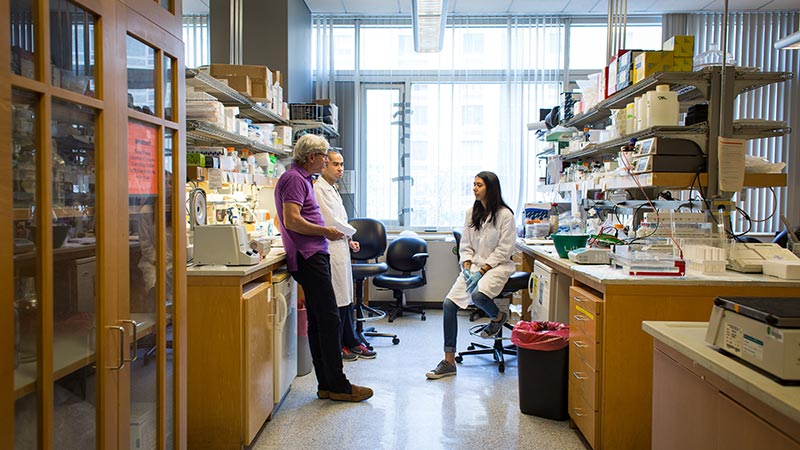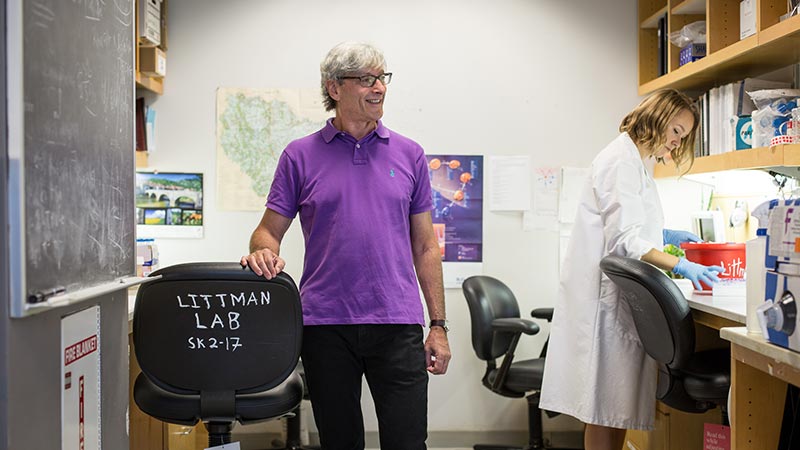Dan Littman has been an explorer since childhood. A prominent immunologist at NYU’s Skirball Institute and an Investigator with the Howard Hughes Medical Institute, Dan was born in Bucharest when Romania was a part of the Soviet bloc. He had what he calls a “relatively normal childhood,” largely unaffected by politics. “I was a young pioneer wearing a red scarf,” he says.
In particular, Dan was captivated by the Space Race, the Cold War competition between Soviet and American superpowers to develop technology and reach new milestones in space exploration. Although he was only 5 years old, he still recalls his excitement over the launch of Sputnik I in 1957, the first satellite put into space by the Soviets. “I was fascinated by the idea of being able to go to outer space and having humans explore other planets and other constellations,” Dan says.

This itch for exploration stayed with him. He immigrated with his family to Philadelphia when he was 11 years old, and upon graduating high school, he was accepted to Princeton University’s engineering program, with aspirations to become an aerospace engineer.
He found, to his surprise, the curriculum to be antithetical to the spirit of exploration. “It was very restrictive,” he says, and within the first year, Dan opted out of the program. He dabbled in various fields before electing to major in biochemistry, but his scientific career really took off when he was accepted into a laboratory for his thesis work. There, he had his first taste of research—and his first intimation that exploration could take place in a lab just as well as in outer space.
Dan recalls another event during his undergraduate studies that would prove decisive in his career: his introduction to immunology. During his time at Princeton, the field was in its nascent stages, and no faculty members were able to teach a course on immunology then. Instead, various experts from around the world were invited to lecture. “I was just totally transfixed by the beautiful questions that were being asked of the immune system,” Dan says, “and I was fascinated by the potential of discovery in this field.”
Dan went on to pursue an MD-PhD program at Washington University in St. Louis. Although he enjoyed the clinical aspect of his education—something he attributes to his father, who was a physician—it was, again, not until he started research that Dan felt he had really hit his stride.
During his graduate studies, Dan first started working with T-lymphocytes, important players in the immune system. T-lymphocytes help the immune system differentiate between the self—cells that are part of the host organism—and non-self, such as harmful bacteria, fungi, or viruses. Although his graduate thesis was based on a hypothesis that couldn’t be proved at the time, it sparked an interest in T-lymphocytes that has lasted throughout his career.

Dan’s post-graduate research was conducted in the lab of Richard Axel at Columbia University. There, he identified the genes responsible for molecules expressed on T-lymphocytes that define two subsets: the CD4 protein on “helper” T-cells, which assist in the production of antibodies, and the CD8 protein on “killer” T-cells, which destroy infected or otherwise undesirable cells.
As Dan was setting up his own lab at the University of California, San Francisco, the AIDS epidemic was growing in the United States, and immunologists, Dan among them, were scrambling to find out more about the virus. “It was clear very early on that HIV primarily infects T-helper cells, the CD4 cells that we worked on,” he said. Dan and other scientists confirmed that CD4 molecules were indeed the receptors that allowed the virus to bind to T-lymphocyte cells.
However, it also became clear that there was another element at play; CD4 molecules alone in mouse cells did not allow the virus to infect. Instead, Dan, along with other groups, found that HIV also hijacks a protein called CCR5 on the surface of helper T-cells, in order to infect the cell. This discovery of the mechanism of HIV’s entry into T-cells paved the way for the HIV drug maraviroc, an antiretroviral drug that blocks the interaction of HIV with CCR5.

In 1995, Dan accepted a professorship in molecular immunology at NYU’s Skirball Institute, where he continued his work with T-lymphocytes. He and his team uncovered a gene switch called RORgammat, which regulates the development of a subset of T-helper cells that produce Interleukin 17. These cells, called Th-17 cells, are important for protecting body surfaces, like skin or the lining of intestines, from harmful microorganisms; however, they are also known to turn against host tissues and cause autoimmune diseases such as psoriasis, multiple sclerosis, arthritis, and inflammatory bowel disease.
RORgammat has thus become an attractive target for potential treatments of autoimmune diseases, and there are now many pharmaceutical and biotechnology companies working on treatments that inhibit the function of RORgammat; some of these treatments are currently in clinical trials.
Dan’s work with RORgammat and Th-17 cells showed, however, that immune response differed among individuals. Specifically, animals that had been treated with antibiotics were found to have a marked reduction in Th-17 cells, leading Dan and his team to turn toward the newest realm in immunology, the study of an organism’s microbiome and how it can influence the immune system in both beneficial and harmful ways.
“The study of the microbiota is one of the hottest areas in the biomedical sciences right now,” says Dan. “But it’s only in the last half dozen years or so that it’s been possible to study the microbiota, to a much greater extent, in the context of the immune system.”
So it’s no surprise that Dan is right in the midst of it; from the earliest days of immunology, he has been a tireless pioneer breaking new ground. Now, as immunology turns new corners, we look forward to seeing what the Vilcek Prizewinner in Biomedical Science will unearth in his explorations.